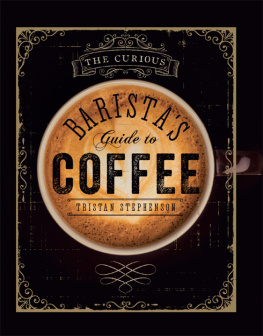M AKING YOUR OWN G OURMET C OFFEE D RINKS  Also by Mathew Tekulsky
Also by Mathew Tekulsky  Making Your Own Gourmet Soft DrinksMaking Your Own Gourmet Chocolate DrinksMaking Your Own Gourmet Tea DrinksBackyard Birdfeeding for BeginnersThe Hummingbird GardenThe Butterfly Garden
Making Your Own Gourmet Soft DrinksMaking Your Own Gourmet Chocolate DrinksMaking Your Own Gourmet Tea DrinksBackyard Birdfeeding for BeginnersThe Hummingbird GardenThe Butterfly Garden
 Copyright 2013 by Mathew Tekulsky All Rights Reserved. No part of this book may be reproduced in any manner without the express written consent of the publisher, except in the case of brief excerpts in critical reviews or articles. All inquiries should be addressed to Skyhorse Publishing, 307 West 36th Street, 11th Floor, New York, NY 10018. Skyhorse Publishing books may be purchased in bulk at special discounts for sales promotion, corporate gifts, fund-raising, or educational purposes. Special editions can also be created to specifications. For details, contact the Special Sales Department, Skyhorse Publishing, 307 West 36th Street, 11th Floor, New York, NY 10018 or info@skyhorsepublishing.com.
Copyright 2013 by Mathew Tekulsky All Rights Reserved. No part of this book may be reproduced in any manner without the express written consent of the publisher, except in the case of brief excerpts in critical reviews or articles. All inquiries should be addressed to Skyhorse Publishing, 307 West 36th Street, 11th Floor, New York, NY 10018. Skyhorse Publishing books may be purchased in bulk at special discounts for sales promotion, corporate gifts, fund-raising, or educational purposes. Special editions can also be created to specifications. For details, contact the Special Sales Department, Skyhorse Publishing, 307 West 36th Street, 11th Floor, New York, NY 10018 or info@skyhorsepublishing.com.
Skyhorse and Skyhorse Publishing are registered trademarks of Skyhorse Publishing, Inc., a Delaware corporation. www.skyhorsepublishing.com 10 9 8 7 6 5 4 3 2 1 Library of Congress Cataloging-in-Publication Data is available on file. ISBN: 978-1-62087-704-3 Printed in China To my mother, Patience Fish Tekulsky, who is an inspiration 
Acknowledgments

I
would like to thank everyone at Skyhorse Publishing for making this book possible, especially Tony Lyons. I would also like to thank my editor Kristin Kulsavage, and my literary agent, Peter Beren, for their support and encouragement.
Introduction

F
or centuries, people have been enjoying coffee. From the Arabian and Turkish coffeehouses of the sixteenth century on through the explosion of Londons coffeehouses in the seventeenth century, citizens of the world have been brought together by their shared love of this tasty and uplifting beverage, as well as the charming companionship of like-minded friends.  In the past few years, however, there has been a dramatic increase in the popularity of specialty coffee shops in the United States.
In the past few years, however, there has been a dramatic increase in the popularity of specialty coffee shops in the United States.  In the past few years, however, there has been a dramatic increase in the popularity of specialty coffee shops in the United States.
In the past few years, however, there has been a dramatic increase in the popularity of specialty coffee shops in the United States.
Whereas people were once just interested in having a standard cup of coffee, now they not only enjoy a regular espresso or cappuccino at the coffee bar, theyre also ordering specialty drinks with names such as Cappuccino Royale, Espresso con Panna, Mochaccino, and Latte Macchiato.  And like wine connoisseurs, they are choosing coffee beans for home use with such names as Colombian Supremo, Ethiopian Harrar, Kona, and Jamaican Blue Mountain. Various specialty coffee shops also have their own house blends, or they may call a certain blend Gazebo, Andes Blend, or Swedish Supreme.
And like wine connoisseurs, they are choosing coffee beans for home use with such names as Colombian Supremo, Ethiopian Harrar, Kona, and Jamaican Blue Mountain. Various specialty coffee shops also have their own house blends, or they may call a certain blend Gazebo, Andes Blend, or Swedish Supreme.  With this book, you will not only learn how to brew a great cup of gourmet coffee at home, using a variety of techniques, you will also discover how to incorporate this coffee into many of the most delicious gourmet coffee drinks that are being served in the best specialty coffee shops around the country today. And you will learn how to make many traditional coffee drinks that have been popular for generations.
With this book, you will not only learn how to brew a great cup of gourmet coffee at home, using a variety of techniques, you will also discover how to incorporate this coffee into many of the most delicious gourmet coffee drinks that are being served in the best specialty coffee shops around the country today. And you will learn how to make many traditional coffee drinks that have been popular for generations.  In addition, once you have tried the recipes included here, you will probably want to experiment on your own with different ingredients, depending on your own tastes.
In addition, once you have tried the recipes included here, you will probably want to experiment on your own with different ingredients, depending on your own tastes.
You may even come up with a few new gourmet coffee drinks!

The Various Coffee Beans You Can Use

Before we start making drinks, we should learn a little bit about the various beans you can use, the type of equipment available for making coffee, and a few other useful tips that will help you do such things as keep your coffee fresh, grind the beans for maximum usability, steam your milk properly for cappuccinos, and prepare your iced coffee the right way. Coffee comes from the seed of a coffee plant, which is processed and then roasted according to various specifications. The best coffee in the world comes from the
Coffea arabica plant, which grows at high altitudes throughout the equatorial regions of the world. Originally discovered growing wild in Ethiopia in ancient times, this plant was taken to Yemen by the Arabs and cultivated there as early as the sixth century. In the early 1700s, the Dutch began cultivating descendants of these original plants in Java, and from that time on, the cultivation of the
C. arabica plant spread to many areas of Central America, South America, and Africa.
Another species of coffee plant, Coffea robusta, is also grown commercially (primarily in Africa), but this plant is used mostly for the lower grades of coffee that are on the market today. Depending on where in the world your coffee is grownfrom Indonesia to Central and South America to Africa and the Middle Eastit will have its own distinct taste and body. Coffee from Java, for instance, is earthy tasting and full-bodied, while beans from Costa Rica produce a lighter, more tangy cup of coffee. Columbian and Brazilian coffees are more middle-of-the-road types, providing a mild taste that can easily be blended with other beans. Coffee from Kenya, on the other hand, has a strong, winy taste. Indeed, coffee from various regions of the same country will have its own unique flavor, depending on such factors as altitude, rainfall, and soil qualityand coffee from different plantations within the same region will even taste different from each other.
Therefore, todays specialty coffee wholesalers and retailers send coffee tasters all over the world in search of the best-tasting coffee crop from each region. After the green coffee beans are shipped to the United States, they must be roasted. This involves heating the beans at around 400F for about 5 to 15 minutes (depending on the temperature), while rotating them in large bins. Most beans are light or medium roasted, producing a light- or medium-brown color and mild taste. Viennese or dark-roasted coffee produces a darker brown bean and an almost burnt (yet tangy) taste. The darkest roast (called espresso, Italian, or French) has a dark brown to almost black color and a burnt to charcoaly taste.
Next page















 Also by Mathew Tekulsky
Also by Mathew Tekulsky  Making Your Own Gourmet Soft DrinksMaking Your Own Gourmet Chocolate DrinksMaking Your Own Gourmet Tea DrinksBackyard Birdfeeding for BeginnersThe Hummingbird GardenThe Butterfly Garden
Making Your Own Gourmet Soft DrinksMaking Your Own Gourmet Chocolate DrinksMaking Your Own Gourmet Tea DrinksBackyard Birdfeeding for BeginnersThe Hummingbird GardenThe Butterfly Garden
 Copyright 2013 by Mathew Tekulsky All Rights Reserved. No part of this book may be reproduced in any manner without the express written consent of the publisher, except in the case of brief excerpts in critical reviews or articles. All inquiries should be addressed to Skyhorse Publishing, 307 West 36th Street, 11th Floor, New York, NY 10018. Skyhorse Publishing books may be purchased in bulk at special discounts for sales promotion, corporate gifts, fund-raising, or educational purposes. Special editions can also be created to specifications. For details, contact the Special Sales Department, Skyhorse Publishing, 307 West 36th Street, 11th Floor, New York, NY 10018 or info@skyhorsepublishing.com.
Copyright 2013 by Mathew Tekulsky All Rights Reserved. No part of this book may be reproduced in any manner without the express written consent of the publisher, except in the case of brief excerpts in critical reviews or articles. All inquiries should be addressed to Skyhorse Publishing, 307 West 36th Street, 11th Floor, New York, NY 10018. Skyhorse Publishing books may be purchased in bulk at special discounts for sales promotion, corporate gifts, fund-raising, or educational purposes. Special editions can also be created to specifications. For details, contact the Special Sales Department, Skyhorse Publishing, 307 West 36th Street, 11th Floor, New York, NY 10018 or info@skyhorsepublishing.com.

 In the past few years, however, there has been a dramatic increase in the popularity of specialty coffee shops in the United States.
In the past few years, however, there has been a dramatic increase in the popularity of specialty coffee shops in the United States.  And like wine connoisseurs, they are choosing coffee beans for home use with such names as Colombian Supremo, Ethiopian Harrar, Kona, and Jamaican Blue Mountain. Various specialty coffee shops also have their own house blends, or they may call a certain blend Gazebo, Andes Blend, or Swedish Supreme.
And like wine connoisseurs, they are choosing coffee beans for home use with such names as Colombian Supremo, Ethiopian Harrar, Kona, and Jamaican Blue Mountain. Various specialty coffee shops also have their own house blends, or they may call a certain blend Gazebo, Andes Blend, or Swedish Supreme.  With this book, you will not only learn how to brew a great cup of gourmet coffee at home, using a variety of techniques, you will also discover how to incorporate this coffee into many of the most delicious gourmet coffee drinks that are being served in the best specialty coffee shops around the country today. And you will learn how to make many traditional coffee drinks that have been popular for generations.
With this book, you will not only learn how to brew a great cup of gourmet coffee at home, using a variety of techniques, you will also discover how to incorporate this coffee into many of the most delicious gourmet coffee drinks that are being served in the best specialty coffee shops around the country today. And you will learn how to make many traditional coffee drinks that have been popular for generations.  In addition, once you have tried the recipes included here, you will probably want to experiment on your own with different ingredients, depending on your own tastes.
In addition, once you have tried the recipes included here, you will probably want to experiment on your own with different ingredients, depending on your own tastes.
